Directional short-circuit and earth fault indicator ComPass B 2.0 with high-precision monitoring and ComPass Bs 2.0 or ComPass D with switching control function
Monitoring for the grid analysis ComPass 2.0
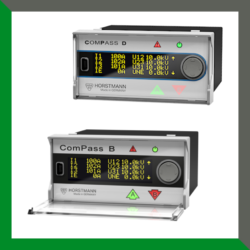
The ComPass B 2.0 is particularly suitable for use in those substations in a medium voltage network that feature a remote-control connection. In addition to the short-circuit and earth fault function, ComPass B 2.0 supplies the collected measured values of current, voltage and power from the station for transmission to the control room. For all measured values limits can be defined, which can also be transmitted to the control room.
In addition to the functions of the ComPass B 2.0, ComPass Bs 2.0 and ComPass D offer a control function for switching a load-break switch or circuit-breaker. A free assignment of binary inputs in combination with a freely programmable logic (PLC functionality) enables the user to define the switching conditions in a flexible manner.
ComPass D is a directional short-circuit and earth fault indicator to which the monitoring and control function is performed via Ethernet, unlike ComPass Bs 2.0 where this function is realized through RS485/Modbus-RTU.
Short-circuit and earth fault indicator ComPass A 2.0 with high-precision measurement
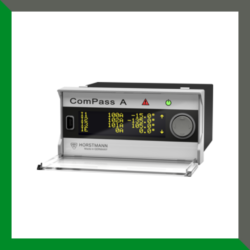
The ComPass A 2.0 is suitable for use in substations with a remote-control connection of the electrical power distribution in a medium voltage network. Trip current values and pre-fault current values are logged with time stamp. In addition to the short-circuit and earth fault function, the ComPass A 2.0 measures the temperature, for example of a transformer or the transformer station with the PT100 sensor. The ComPass A 2.0 provides the collected information, measured values and their limits, for transmission to the control room.
Directional fault indication for fast fault location Sigma D
Directional short-circuit and earth fault indicator Sigma D, Sigma D⁺ and Sigma D⁺⁺
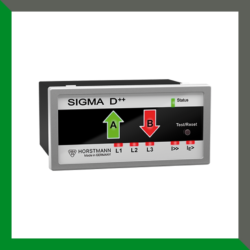
Sigma D, Sigma D+ and Sigma D++ are combined directional short-circuit and directional earth fault indicators for medium voltage distribution networks. The devices are current sensor powered. The voltage information will be taken from an integrated voltage detecting system (Wega series), from an HR interface or capacitive post insulators.
The Sigma D+ provides additional earth fault detection methods for compensated and isolated neutral networks. For the transient earth fault method with the Sigma D+ summation current sensor is mandatory, auxiliary supply is optional.
The Sigma D++ provides also additional earth fault detection methods for compensated and isolated neutral networks. For the transient earth fault method only three single-phase current sensors are needed, but auxiliary supply is mandatory. The connection of a summation current sensor is optional. For all other methods no auxiliary supply is needed, if the load current is >5 A.
Directional fault indicator Sigma DM with Modbus communication
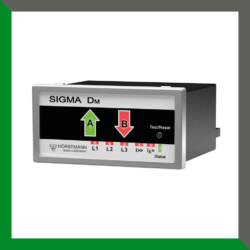
The Sigma DM is a directional short-circuit and earth fault indicator with clear fault direction indication. It is equipped with an RS485 interface for the transmission of measured values and error messages via the Modbus RTU protocol. With Sigma DM, 6 earth fault location methods are provided for all neutral point treatments and also active earth fault location methods such as pulse location are supported. Two digital inputs are freely configurable and can detect status messages such as switch states in addition to the test/reset function. Readiness for operation is indicated via the status LED. No auxiliary voltage is required for fault detection, if the operating current is >5 A, except for earth fault transient method. For remote data transmission via RS485 with Modbus RTU, an auxiliary voltage must be connected.
Phase-selective fault indication Sigma 2.0
Short-circuit indicator Sigma 2.0
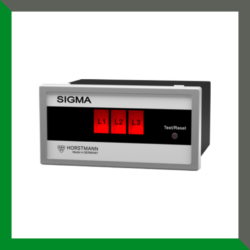
The Sigma 2.0 is a phase-selective short-circuit indicator. It is designed to detect, display and remotely indicate short-circuits in medium voltage distribution networks. The current is measured via three single-phase current sensors. By using the new sensors retrofit to more advanced indicator series is possible at any time, without changing the sensors. There are two response criteria for short-circuit detection, fixed response value with response delay or auto-adjustment based on load current.
Sigma 2.0 AC/DC version can be connected to an auxiliary supply. If the auxiliary power drops out in the event of a fault, the LED indicator can operate using a back-up capacitor for up to 8 hours.
Short-circuit and earth fault indicator Sigma F+E 2.0 and Sigma F+E 3 2.0
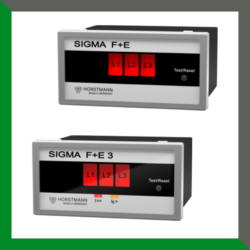
Sigma F+E 2.0 is a combined short-circuit and earth fault indicator. Sigma F+E 3 2.0 is also a combined short-circuit and earth fault indicator having in addition two dedicated LEDs to display the exact fault type: the red LED I>> signals a short-circuit, while the yellow LED IE> signals an earth fault.
Due to the measuring principle the earth fault indication is suitable for low-impedance, solidly and isolated earthed neutral networks. The current is measured via three single-phase current sensors. This allows phase-selective fault detection and indication. There are two response criteria for short-circuit detection, fixed response values with response delay or auto-adjustment based on load current.
Sigma F+E 2.0 AC/DC and Sigma F+E 3 2.0 AC/DC versions can be connected to an auxiliary supply. If the auxiliary power drops out in the event of a fault, the LED indicator can operate using a back-up capacitor for up to 8 hours.
Short-circuit and earth fault indicator for retrofit Sigma plus
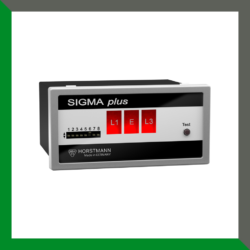
The Sigma plus features all the functions provided by the Sigma and Sigma F+E devices thus capable of being used as a short-circuit indicator or as a combined short-circuit and earth fault indicator. This device is ready to be used for retrofit: change or replace old indicators with the Sigma plus without replacing current transformers already existing in the switchgear. The Sigma plus features a selection switch which is used to adapt the device to all current transformers.
Sigma plus AC/DC version can be connected to an auxiliary supply.
Short-circuit and earth fault indicators with fiber optic cables for transferring signals Opto 3.0
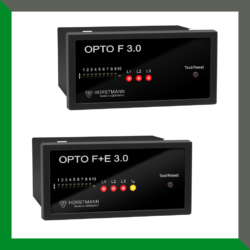
The Opto F 3.0 is a short-circuit indicator, while the Opto F+E 3.0 is a combined short-circuit and earth fault indicator, both are designed to detect, display and remotely indicate short-circuit currents in medium voltage distribution networks. This indicator units can be used in all medium voltage switchgear installations. Fiber optic cables provide electrical isolation between the current transformers, mounted on unscreened cable or busbar, and the display unit when transferring signals. The current transformers have an integrated trip threshold detection capability. When the pre-set trip current is reached or exceeded, light pulses will be emitted and transmitted through the fiber optic cables to the indicator.
Short-circuit indicators Alpha E and Alpha M
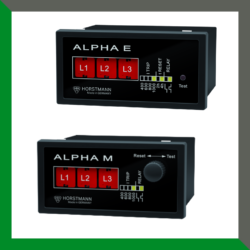
The Alpha is designed to detect, display and remotely indicate short-circuit faults in medium voltage distribution networks. The indication is tripped by a short-circuit current and remains active until the device is reset. Alpha E indicator can be reset remotely while Alpha M can be reset manually.
Earth fault indicator Earth Zero and Earth Zero Flag
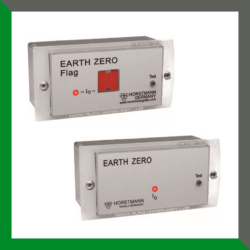
The Earth Zero is an earth fault indicator designed to detect, locally indicate and remotely report earth fault currents in medium voltage distribution networks. An earth fault current transformer monitors the summation current of all three conductors while the electronics of the display unit evaluates the measurements. When the fault sensitivity threshold is exceeded, a red LED will start flashing and a mechanical flag becomes visible (Earth Zero Flag). In addition to that, the remote indication contacts are energized. A system-specific external signal lamp (optionally available) is also activated.
Indicator for trip display with remote monitoring Trip Flag
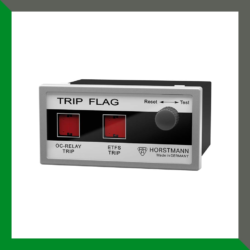
The Trip Flag is a drop indicator relay for two independent indications. It is suitable for the trip display of current transformers powered protection devices with electrical impulse output. In addition to the display, output relays are activated. Each output has 2 changeover contacts. The output contacts and the display are latching and are reset manually via a rotary knob. The Trip Flag is suitable for protection relays having the electrical impulse of the outputs of 24 V DC and E ≥ 0.01 Ws.
Monitoring of return currents in railway systems with Polaris

The Polaris performs a continuous monitoring of parallel connecting cables in railway systems, which typically carry the return current. If the connection of one of these cables deteriorates, it will be detected and selectively displayed. In addition, any undesired increase of the earth potential is detected and displayed. The above events are remotely reported to the control room. This enables the railway asset management to send the service team to the point of failure in a targeted manner.
